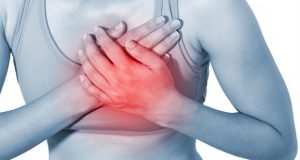
Cardiac arrest – causes, side effects and treatments at NaturalPedia.com
Wednesday, February 07, 2018 by Zoey Sky
http://www.naturalpedia.com/cardiac-arrest-causes-side-effects-and-treatments-at-naturalpedia-com.html

Cardiac arrest, also known as sudden cardiac arrest (SCD), often occurs without warning. It is caused by an “electrical” malfunction in the heart that causes arrhythmia (or an irregular heartbeat).
If the heart’s pumping action is disrupted, it is unable to pump blood to the brain, lungs and other vital organs. When this happens, an individual will lose consciousness within seconds. Once a person’s pulse stops, “death can occur within minutes” if they do not receive treatment immediately.
Cardiac arrest is often confused with a heart attack. Contrary to popular belief, the two terms are not interchangeable. A heart attack occurs when “blood flow to the heart is blocked” while cardiac arrest refers to when “the heart malfunctions and suddenly stops beating.” Keep in mind that a heart attack is a “circulation” problem, and cardiac arrest is an “electrical” problem.

Known side effects of cardiac arrest
The two leading risk factors for cardiac arrest include:
- Cases of a previous heart attack – An individual’s person’s risk of cardiac arrest is higher the first six months following a heart attack. About 75 of cardiac arrest cases are linked to a previous heart attack.
- Coronary artery disease – Risk factors for coronary artery disease include smoking, family history of cardiovascular disease, high cholesterol, or an enlarged heart. At least 80 percent of cardiac arrest cases are linked to this condition.
Other risk factors include:
- Prior case/s of cardiac arrest
- Family history of cardiac arrest
- Personal or family history of certain abnormal heart rhythms (such as the long QT syndrome, Wolff-Parkinson-White syndrome, extremely low heart rates, or heart block)
- Ventricular tachycardia or ventricular fibrillation after a heart attack
- History of congenital heart defects or blood vessel abnormalities
- Obesity
- Diabetes
- Recreational drug abuse
Symptoms of cardiac arrest may include:
- Fainting/loss of consciousness
- No heartbeat/pulse can be felt
- Racing heartbeat
- Feeling dizzy/lightheaded before fainting.
- An hour before cardiac arrest, some individuals may feel chest pain, shortness of breath, nausea, or they may start vomiting.
Body systems harmed by cardiac arrest
Once an individual suffers cardiac arrest and normal blood circulation grinds to a halt, oxygen delivery to all vital organs also stops.
The organ that suffers the most because of a lack of oxygen is the brain. The patient will lose consciousness, and their breathing will be minimized. If the cardiac arrest continues for more than five minutes, permanent brain damage can occur.
The pulse usually observed in the carotid artery in the neck and the wrists and ankles will cease. Take note that cardiac arrest can cause sudden cardiac death (SCD). A heart attack is a major cause of SCD.
Food items or nutrients that may prevent cardiac arrest
Eat more of the foods listed below to prevent cardiac arrest:
- Almonds – Almonds are full of protein, and they’re rich in monounsaturated fats, which can help reduce the risk of heart disease.
- Dark chocolate – Dark chocolate contains flavanols, which can help reduce blood pressure.
- Oranges – An orange has 60 mg of calcium. This fruit also contains the soluble fiber pectin, which can absorb cholesterol from food and “block its absorption.”
- Soybeans – Soybeans, soy milk, and tofu are all rich in calcium. Soybeans also contain iron, magnesium, protein, and selenium.One and a half servings of tofu (130 g) and about two servings of soy milk (500 milliliters [ml]) would equal the calcium derived from one cup (250 ml) of milk.
Treatments, management plans for cardiac arrest
Treatments and management plans for cardiac arrest include:
- Dialing 911 – Call 911 immediately if you witness someone experiencing sudden cardiac arrest. You can also call your local emergency personnel and perform cardiopulmonary resuscitation (CPR). If done correctly, CPR can save an individual’s life since it helps keep blood and oxygen circulating throughout their body until help arrives.
- An Ambulatory External Defibrillator (AED) – With an AED on hand, there is a higher chance of rescuing the patient with defibrillation using the device. The shorter the time until defibrillation, the higher the individual’s chance of survival. CPR combined with defibrillation offers the best chance of survival.
- Defibrillation – After emergency personnel arrives, defibrillation can help restart the heart. Defibrillation sends an electric shock to the heart via the paddles placed on the chest.
- Hospital care – After successful defibrillation, a lot of patients will need hospital care to “treat and prevent future heart problems.”
Where to learn more
- Few Hospital Patients Survive Cardiac Arrest; CPR Has Made No Improvements in Decades
- Heart stent FAIL: Shocking study shows heart stents are medically useless
- Man goes into cardiac arrest after eating ‘Triple Bypass Burger’ from Las Vegas restaurant ‘Heart Attack Grill’
- New cooling therapy to help cardiac arrest patients avoid brain damage
- Study finds about half of cardiac arrest patients showed these telltale signs before their attack
Summary
Cardiac arrest often occurs without warning. It is caused by an “electrical” malfunction in the heart that causes arrhythmia (or an irregular heartbeat).
Symptoms of cardiac arrest may include fainting/loss of consciousness, no heartbeat/pulse can be felt, or a racing heartbeat.
Treatments and management plans for cardiac arrest include calling 911, using an AED, and hospital care.
Sources include
Tagged Under: Tags: Cardiac Arrest





